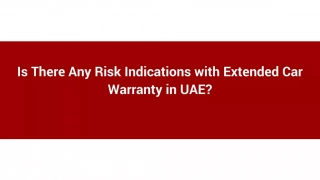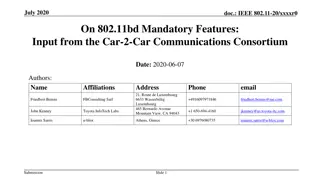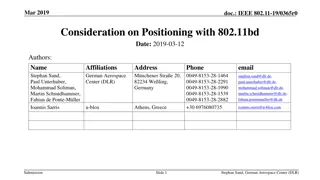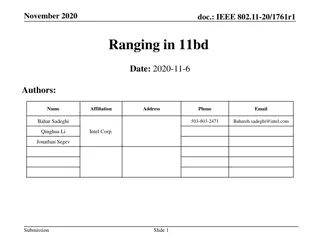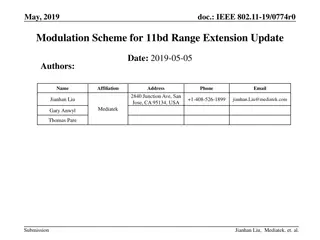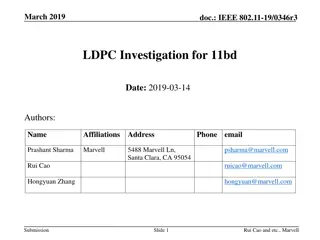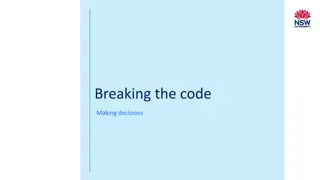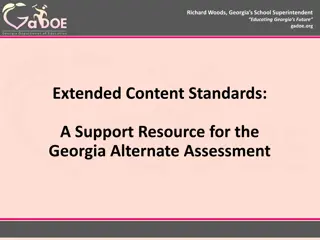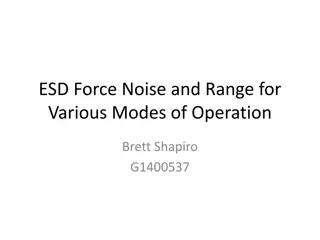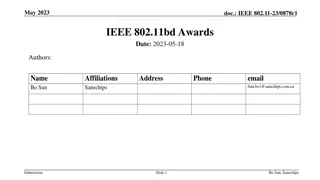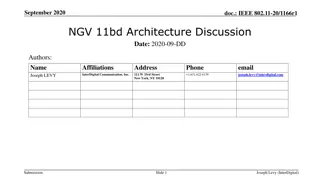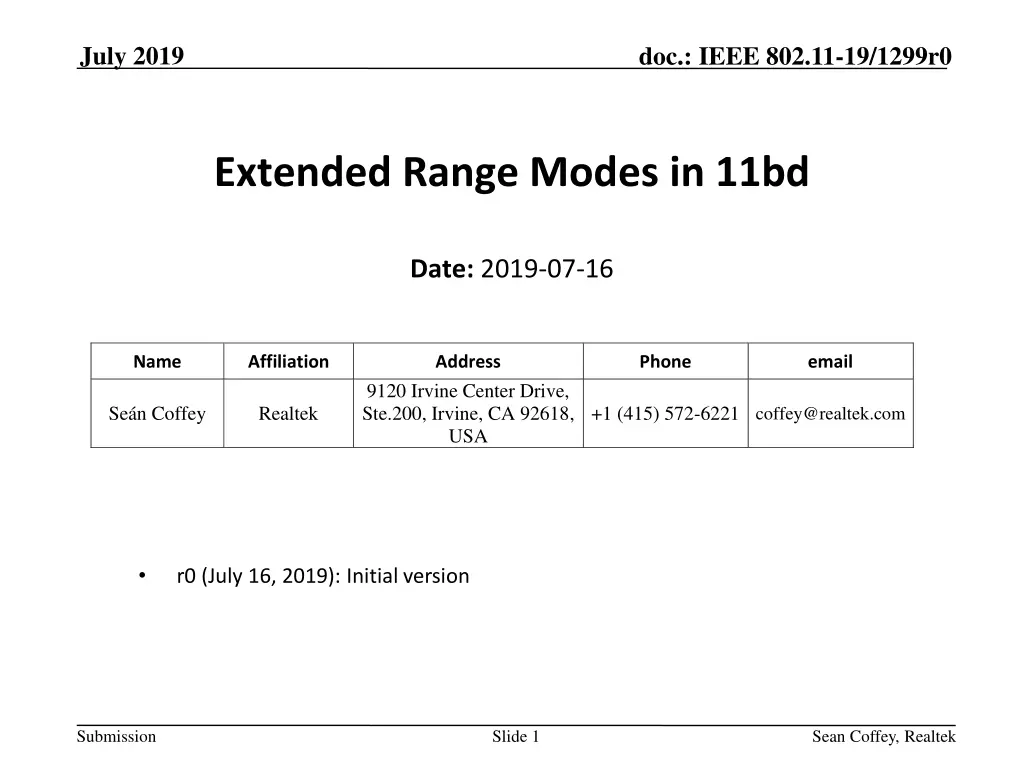
Understanding Extended Range Modes in IEEE 802.11-19/1299r0 Document
Delve into the details of IEEE 802.11-19/1299r0 document discussing Extended Range Modes in 11bd technology. Explore proposals for achieving lower sensitivity levels and the potential impact on market adoption. Discover the technical aspects of DCM and a more general framework for enhancing sensitivity levels through inner codes with varying rates. Uncover the possibilities for extending range capabilities in wireless communication technologies.
Download Presentation

Please find below an Image/Link to download the presentation.
The content on the website is provided AS IS for your information and personal use only. It may not be sold, licensed, or shared on other websites without obtaining consent from the author. If you encounter any issues during the download, it is possible that the publisher has removed the file from their server.
You are allowed to download the files provided on this website for personal or commercial use, subject to the condition that they are used lawfully. All files are the property of their respective owners.
The content on the website is provided AS IS for your information and personal use only. It may not be sold, licensed, or shared on other websites without obtaining consent from the author.
E N D
Presentation Transcript
July 2019 doc.: IEEE 802.11-19/1299r0 Extended Range Modes in 11bd Date: 2019-07-16 Name Affiliation Address Phone email 9120 Irvine Center Drive, Ste.200, Irvine, CA 92618, USA Se n Coffey Realtek +1 (415) 572-6221 coffey@realtek.com r0 (July 16, 2019): Initial version Submission Slide 1 Sean Coffey, Realtek
July 2019 doc.: IEEE 802.11-19/1299r0 Summary The 11bd PAR requires, among other things, at least one mode that achieves at least 3dB lower sensitivity level (longer range), than [3 Mb/s in a 10 MHz channel] [1]. A proposal under consideration [2] defines exactly one mode, that achieves almost exactly 3 dB lower sensitivity level than the referenced mode. The proposal under consideration meets the PAR. But by itself it isn t a game- changer, and probably isn t sufficient (again by itself) to motivate market uptake of an entire new amendment. Us. The new, improved amendment adds new functionality that extends range! Adopters. Sounds great! I m interested how, and how much extra range? Us. There is one new rate, getting about 3 dB lower sensitivity level. Adopters. well, what do we expect adopters to say?. It would be better to extend to much more range, via a family of related modes Submission Slide 2 Sean Coffey, Realtek
July 2019 doc.: IEEE 802.11-19/1299r0 DCM DCM (for BPSK) involves duplicating the left-half tones onto the right-half tones This ignores the extra rotations, but those don t affect sensitivity So the data rate is halved, and the sensitivity in a pure AWGN channel with no preamble losses would be exactly 3 dB better (from combining) In a pure AWGN channel with preamble processing, 3 dB lower Rx power would give worse packet detect, channel estimation, L-SIG decoding, etc., so net gain is slightly less than 3 dB (This is an issue with any range extension modes) With realistic multipath, we expect an extra 1-2 dB in diversity gain (cf. MRC results) Net DCM sensitivity improvement should be expected to be 3-4 dB in most realistic channels We could adapt STBC from 11n to repeat across frequency instead of time, and it would come to essentially the same thing DCM (or equivalently (adapted) STBC) can be seen as simple inner code, taking one bit in and yielding two bits out; easy to decode for LLRs to send to the outer BCC Submission Slide 3 Sean Coffey, Realtek
July 2019 doc.: IEEE 802.11-19/1299r0 A more general framework We could define a family of inner codes with successively lower rates and better sensitivities, spaced at reasonable gaps in sensitivity Along the lines of 802.11a/g s OFDM rates: one basic architecture yielding multiple rates Here is one example of how this could work (retaining DCM and extending it; we could also investigate more complex inner codes with perhaps better sensitivities) Mode 1: DCM (inner (2, 1, 2) code, rate 1.5 Mbps, 3 dB better sensitivity Mode 2: Inner (6, 2, 4) code, rate 1 Mbps, circa 6 dB better sensitivity Mode 3: Inner (12, 2, 8) code, rate 0.5 Mbps, circa 9 dB better sensitivity (same rotations for PAPR whichever we choose--across all three modes) Submission Slide 4 Sean Coffey, Realtek
July 2019 doc.: IEEE 802.11-19/1299r0 Simple modes, contd. II DCM divides tones into two equal sets, 1 tone on left maps to 1 on right Mode 2 divides tones into three equal sets, replicates pairs of tones according to (6, 2, 4) code, with, e.g., generator matrix (101110, 010111) Each two tones on left maps to two tones in middle and two more tones on right (1,0) in leftmost pair of tones 1,0,1,1,1,0 I.e., 1,1 in middle, 1,0 on right (0,1) in leftmost pair of tones 0,1,0,1,1,1 (1,1) in leftmost pair of tones 1,1,1,0,0,1 (i.e., sum of codewords) To decode, run BCJR algorithm on (6,2,4) code to get LLRs Or just calculate p(b1 = 0) = constant x ( p(r1 | c0) + p(r1 | c2)), p(b1 = 1) = constant x ( p(r1 | c1) + p(r1 | c3)), etc. Extending pure DCM would give us a (3,1,3) code Even easier to decode, but around10 log10 (4/3) = 1.25 dB less improvement in sensitivity (Assuming there is no significant change in delta after applying outer code) Submission Slide 5 Sean Coffey, Realtek
July 2019 doc.: IEEE 802.11-19/1299r0 Simple modes, contd. III So data is encoded by BCC, then interleaved Assume we use the regular 48-tone interleaver, then wrap in time This is probably fine, but we could use any other (e.g. 96-tone, more wrapping) Post-interleaver data map to tones in left 1/3, which are grouped into blocks of 2 and then generate data on right as follows: 00 0000 01 1110 (so 4x Hamming distance overall) 10 0111 ( ) 11 1001 (so 2x Hamming distance overall) BCC interleavers are designed to prevent low-weight codewords from mapping to interleaved data with 1 s in close proximity Minimum distance probably increased by 4x, asymptotic coding gain 6 dB (TBV) Even if not, number of nearest neighbors is substantially thinned Submission Slide 6 Sean Coffey, Realtek
July 2019 doc.: IEEE 802.11-19/1299r0 Other issues Other issues (preamble robustness, OBSS interference) can be handled orthogonally One straightforward approach for preambles is to reuse the structure from 11n that indicates new SIG data to follow: I.e., legacy preamble encoded via QPSK, with presence of quadrature component indicating that some number (2 or 3) extra SIG fields are present This could apply to all extended range modes or to some subset Submission Slide 7 Sean Coffey, Realtek
July 2019 doc.: IEEE 802.11-19/1299r0 Conclusion If we re going to extend range, we should go beyond the bare minimum, and provide a really noticeable extension Other things being equal, we should follow the historic path of generating multiple modes from a basic unified architecture There are many ways of achieving this (and we should do due diligence), but a very simple approach can provide lower sensitivities by 3, 6, 9 dB Reuses and extends modes present in 11ax Submission Slide 8 Sean Coffey, Realtek
July 2019 doc.: IEEE 802.11-19/1299r0 References 1. Doc. IEEE 802.11/18-0861r9, 802.11 NGV Proposed PAR , Bo Sun (ZTE), Hongyuan Zhang (Marvell), November 2018 2. Doc. IEEE 802.11/19-0774r1, Modulation Scheme for 11bd Range Extension Update, Jianhan Liu, Gary Anwyl, Thomas Pare (MediaTek), May 2019 Submission Slide 9 Sean Coffey, Realtek


